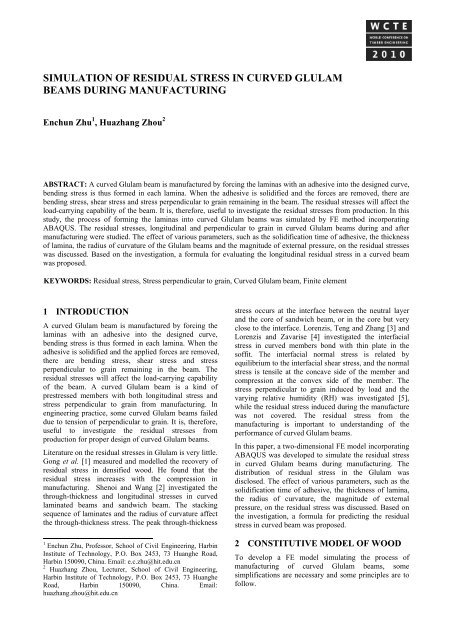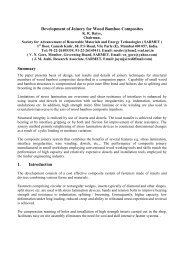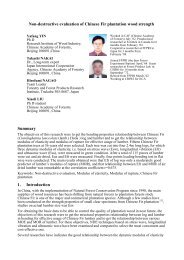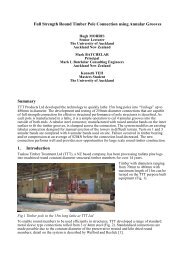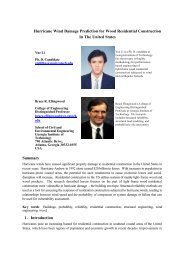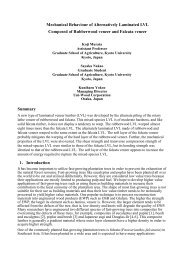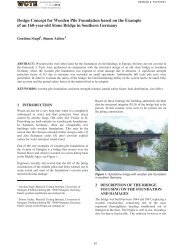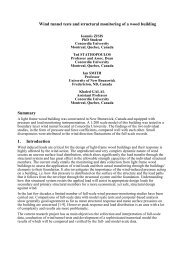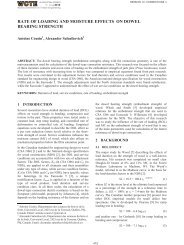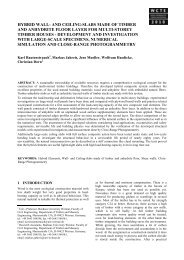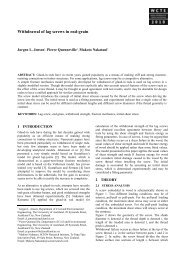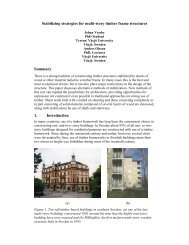simulation of residual stress in curved glulam beams - Engineered ...
simulation of residual stress in curved glulam beams - Engineered ...
simulation of residual stress in curved glulam beams - Engineered ...
You also want an ePaper? Increase the reach of your titles
YUMPU automatically turns print PDFs into web optimized ePapers that Google loves.
SIMULATION OF RESIDUAL STRESS IN CURVED GLULAM<br />
BEAMS DURING MANUFACTURING<br />
Enchun Zhu 1 , Huazhang Zhou 2<br />
ABSTRACT: A <strong>curved</strong> Glulam beam is manufactured by forc<strong>in</strong>g the lam<strong>in</strong>as with an adhesive <strong>in</strong>to the designed curve,<br />
bend<strong>in</strong>g <strong>stress</strong> is thus formed <strong>in</strong> each lam<strong>in</strong>a. When the adhesive is solidified and the forces are removed, there are<br />
bend<strong>in</strong>g <strong>stress</strong>, shear <strong>stress</strong> and <strong>stress</strong> perpendicular to gra<strong>in</strong> rema<strong>in</strong><strong>in</strong>g <strong>in</strong> the beam. The <strong>residual</strong> <strong>stress</strong>es will affect the<br />
load-carry<strong>in</strong>g capability <strong>of</strong> the beam. It is, therefore, useful to <strong>in</strong>vestigate the <strong>residual</strong> <strong>stress</strong>es from production. In this<br />
study, the process <strong>of</strong> form<strong>in</strong>g the lam<strong>in</strong>as <strong>in</strong>to <strong>curved</strong> Glulam <strong>beams</strong> was simulated by FE method <strong>in</strong>corporat<strong>in</strong>g<br />
ABAQUS. The <strong>residual</strong> <strong>stress</strong>es, longitud<strong>in</strong>al and perpendicular to gra<strong>in</strong> <strong>in</strong> <strong>curved</strong> Glulam <strong>beams</strong> dur<strong>in</strong>g and after<br />
manufactur<strong>in</strong>g were studied. The effect <strong>of</strong> various parameters, such as the solidification time <strong>of</strong> adhesive, the thickness<br />
<strong>of</strong> lam<strong>in</strong>a, the radius <strong>of</strong> curvature <strong>of</strong> the Glulam <strong>beams</strong> and the magnitude <strong>of</strong> external pressure, on the <strong>residual</strong> <strong>stress</strong>es<br />
was discussed. Based on the <strong>in</strong>vestigation, a formula for evaluat<strong>in</strong>g the longitud<strong>in</strong>al <strong>residual</strong> <strong>stress</strong> <strong>in</strong> a <strong>curved</strong> beam<br />
was proposed.<br />
KEYWORDS: Residual <strong>stress</strong>, Stress perpendicular to gra<strong>in</strong>, Curved Glulam beam, F<strong>in</strong>ite element<br />
1 INTRODUCTION 1iii<br />
A <strong>curved</strong> Glulam beam is manufactured by forc<strong>in</strong>g the<br />
lam<strong>in</strong>as with an adhesive <strong>in</strong>to the designed curve,<br />
bend<strong>in</strong>g <strong>stress</strong> is thus formed <strong>in</strong> each lam<strong>in</strong>a. When the<br />
adhesive is solidified and the applied forces are removed,<br />
there are bend<strong>in</strong>g <strong>stress</strong>, shear <strong>stress</strong> and <strong>stress</strong><br />
perpendicular to gra<strong>in</strong> rema<strong>in</strong><strong>in</strong>g <strong>in</strong> the beam. The<br />
<strong>residual</strong> <strong>stress</strong>es will affect the load-carry<strong>in</strong>g capability<br />
<strong>of</strong> the beam. A <strong>curved</strong> Glulam beam is a k<strong>in</strong>d <strong>of</strong><br />
pre<strong>stress</strong>ed members with both longitud<strong>in</strong>al <strong>stress</strong> and<br />
<strong>stress</strong> perpendicular to gra<strong>in</strong> from manufactur<strong>in</strong>g. In<br />
eng<strong>in</strong>eer<strong>in</strong>g practice, some <strong>curved</strong> Glulam <strong>beams</strong> failed<br />
due to tension <strong>of</strong> perpendicular to gra<strong>in</strong>. It is, therefore,<br />
useful to <strong>in</strong>vestigate the <strong>residual</strong> <strong>stress</strong>es from<br />
production for proper design <strong>of</strong> <strong>curved</strong> Glulam <strong>beams</strong>.<br />
Literature on the <strong>residual</strong> <strong>stress</strong>es <strong>in</strong> Glulam is very little.<br />
Gong et al. [1] measured and modelled the recovery <strong>of</strong><br />
<strong>residual</strong> <strong>stress</strong> <strong>in</strong> densified wood. He found that the<br />
<strong>residual</strong> <strong>stress</strong> <strong>in</strong>creases with the compression <strong>in</strong><br />
manufactur<strong>in</strong>g. Shenoi and Wang [2] <strong>in</strong>vestigated the<br />
through-thickness and longitud<strong>in</strong>al <strong>stress</strong>es <strong>in</strong> <strong>curved</strong><br />
lam<strong>in</strong>ated <strong>beams</strong> and sandwich beam. The stack<strong>in</strong>g<br />
sequence <strong>of</strong> lam<strong>in</strong>ates and the radius <strong>of</strong> curvature affect<br />
the through-thickness <strong>stress</strong>. The peak through-thickness<br />
1 Enchun Zhu, Pr<strong>of</strong>essor, School <strong>of</strong> Civil Eng<strong>in</strong>eer<strong>in</strong>g, Harb<strong>in</strong><br />
Institute <strong>of</strong> Technology, P.O. Box 2453, 73 Huanghe Road,<br />
Harb<strong>in</strong> 150090, Ch<strong>in</strong>a. Email: e.c.zhu@hit.edu.cn<br />
2 Huazhang Zhou, Lecturer, School <strong>of</strong> Civil Eng<strong>in</strong>eer<strong>in</strong>g,<br />
Harb<strong>in</strong> Institute <strong>of</strong> Technology, P.O. Box 2453, 73 Huanghe<br />
Road, Harb<strong>in</strong> 150090, Ch<strong>in</strong>a. Email:<br />
huazhang.zhou@hit.edu.cn<br />
<strong>stress</strong> occurs at the <strong>in</strong>terface between the neutral layer<br />
and the core <strong>of</strong> sandwich beam, or <strong>in</strong> the core but very<br />
close to the <strong>in</strong>terface. Lorenzis, Teng and Zhang [3] and<br />
Lorenzis and Zavarise [4] <strong>in</strong>vestigated the <strong>in</strong>terfacial<br />
<strong>stress</strong> <strong>in</strong> <strong>curved</strong> members bond with th<strong>in</strong> plate <strong>in</strong> the<br />
s<strong>of</strong>fit. The <strong>in</strong>terfacial normal <strong>stress</strong> is related by<br />
equilibrium to the <strong>in</strong>terfacial shear <strong>stress</strong>, and the normal<br />
<strong>stress</strong> is tensile at the concave side <strong>of</strong> the member and<br />
compression at the convex side <strong>of</strong> the member. The<br />
<strong>stress</strong> perpendicular to gra<strong>in</strong> <strong>in</strong>duced by load and the<br />
vary<strong>in</strong>g relative humidity (RH) was <strong>in</strong>vestigated [5],<br />
while the <strong>residual</strong> <strong>stress</strong> <strong>in</strong>duced dur<strong>in</strong>g the manufacture<br />
was not covered. The <strong>residual</strong> <strong>stress</strong> from the<br />
manufactur<strong>in</strong>g is important to understand<strong>in</strong>g <strong>of</strong> the<br />
performance <strong>of</strong> <strong>curved</strong> Glulam <strong>beams</strong>.<br />
In this paper, a two-dimensional FE model <strong>in</strong>corporat<strong>in</strong>g<br />
ABAQUS was developed to simulate the <strong>residual</strong> <strong>stress</strong><br />
<strong>in</strong> <strong>curved</strong> Glulam <strong>beams</strong> dur<strong>in</strong>g manufactur<strong>in</strong>g. The<br />
distribution <strong>of</strong> <strong>residual</strong> <strong>stress</strong> <strong>in</strong> the Glulam was<br />
disclosed. The effect <strong>of</strong> various parameters, such as the<br />
solidification time <strong>of</strong> adhesive, the thickness <strong>of</strong> lam<strong>in</strong>a,<br />
the radius <strong>of</strong> curvature, the magnitude <strong>of</strong> external<br />
pressure, on the <strong>residual</strong> <strong>stress</strong> was discussed. Based on<br />
the <strong>in</strong>vestigation, a formula for predict<strong>in</strong>g the <strong>residual</strong><br />
<strong>stress</strong> <strong>in</strong> <strong>curved</strong> beam was proposed.<br />
2 CONSTITUTIVE MODEL OF WOOD<br />
To develop a FE model simulat<strong>in</strong>g the process <strong>of</strong><br />
manufactur<strong>in</strong>g <strong>of</strong> <strong>curved</strong> Glulam <strong>beams</strong>, some<br />
simplifications are necessary and some pr<strong>in</strong>ciples are to<br />
follow.
The thickness <strong>of</strong> gluel<strong>in</strong>e is neglected due to the fact that<br />
gluel<strong>in</strong>e is only a t<strong>in</strong>y part <strong>of</strong> Glulam, and the typical<br />
thickness is only 0.076-0.152mm [6]. The thickness <strong>of</strong><br />
gluel<strong>in</strong>e is very m<strong>in</strong>or compared with the dimensions <strong>of</strong><br />
Glulam members. Thus, the thickness <strong>of</strong> gluel<strong>in</strong>e is<br />
neglected <strong>in</strong> the FE modell<strong>in</strong>g. But the bond<br />
performance <strong>of</strong> adhesive <strong>in</strong> gluel<strong>in</strong>e is still considered.<br />
The bond performance is different <strong>in</strong> different stages <strong>of</strong><br />
manufactur<strong>in</strong>g. In the stage <strong>of</strong> forc<strong>in</strong>g the lam<strong>in</strong>as <strong>in</strong>to<br />
the <strong>curved</strong> shape, the glue is still a liquid. It has no bond<br />
effect and can also reduce the friction between lam<strong>in</strong>as.<br />
While when the adhesive is solidified, the bond effect is<br />
acquired. Lam<strong>in</strong>as can neither slip relatively nor separate<br />
even when the pressure is removed. The deformation is<br />
so restra<strong>in</strong>ed that a <strong>curved</strong> Glulam beam is completed.<br />
Thus rema<strong>in</strong>s the <strong>residual</strong> <strong>stress</strong>. Because <strong>of</strong> the t<strong>in</strong>y<br />
thickness <strong>of</strong> gluel<strong>in</strong>e, the dimension <strong>of</strong> gluel<strong>in</strong>e is<br />
neglected <strong>in</strong> FE model. The bond performance <strong>of</strong><br />
adhesive is considered through the frictional behaviour<br />
and separat<strong>in</strong>g behaviour <strong>in</strong> FE modell<strong>in</strong>g-when the<br />
adhesive is liquid, the coefficient <strong>of</strong> friction is chosen as<br />
a small value and separat<strong>in</strong>g between lam<strong>in</strong>as is allowed;<br />
when the adhesive is solidified, the coefficient <strong>of</strong> friction<br />
is chosen as a large value (rough friction) and separat<strong>in</strong>g<br />
between lam<strong>in</strong>as is prevented.<br />
The material <strong>of</strong> Glulam is considered as an orthotropic<br />
material. For a two-dimensional problem, the plane<br />
<strong>stress</strong> relationship is<br />
⎡ 1 υ12<br />
⎤<br />
⎢ − 0 ⎥<br />
E1 E1<br />
⎧ε1 ⎫ ⎢ ⎥⎧σ11⎫<br />
⎪ ⎪ ⎢ υ12<br />
1 ⎥⎪<br />
⎪<br />
⎨ε2 ⎬= ⎢− 0 ⎥⎨σ22⎬<br />
(1)<br />
⎪ E1 E2<br />
γ ⎪ ⎢ ⎥⎪<br />
12 τ ⎪<br />
⎩ ⎭ ⎢ 12<br />
1 ⎥⎩<br />
⎭<br />
⎢ 0 0 ⎥<br />
⎢⎣ G12<br />
⎥⎦<br />
where 1 E , 2<br />
wood; 12 G is the modulus <strong>of</strong> shear; υ 12 is Poisson’s ratio;<br />
E are the moduli <strong>of</strong> elasticity (MOE) <strong>of</strong><br />
σ 11 , σ 22 and τ 12 are the <strong>stress</strong> components; ε 11 , ε 22 and<br />
γ are the stra<strong>in</strong> components.<br />
12<br />
3 NUMERICAL SIMULATION OF<br />
STRESSES INDUCED FROM<br />
MANUFACTURING<br />
3.1 MANUFACTURING PROCEDURE<br />
The process <strong>of</strong> manufactur<strong>in</strong>g <strong>curved</strong> Glulam <strong>beams</strong> is<br />
as follows. The lam<strong>in</strong>as sprayed with an adhesive are<br />
pressed on a rigid mould with designed curvature, and<br />
the pressure by apply<strong>in</strong>g external forces is kept until the<br />
designed strength <strong>of</strong> adhesive is reached. Then the<br />
external forces are removed, the <strong>curved</strong> shape can be<br />
reta<strong>in</strong>ed due to the effect <strong>of</strong> bond. The procedure can be<br />
divided <strong>in</strong>to two stages <strong>in</strong> FE modell<strong>in</strong>g. Stage 1, to<br />
press the stacked lam<strong>in</strong>as <strong>in</strong>to the designed curve; Stage<br />
2, to release the pressure after solidification <strong>of</strong> the<br />
adhesive between lam<strong>in</strong>as. In stage 1, the coefficient <strong>of</strong><br />
friction between lam<strong>in</strong>as is reduced by the liquid<br />
adhesive. However, there is still some friction that<br />
depends on the craftsmanship like adhesive apply<strong>in</strong>g<br />
(spray<strong>in</strong>g/brush<strong>in</strong>g) and the type <strong>of</strong> the adhesive.<br />
Because <strong>of</strong> the different solidification times <strong>of</strong> adhesive,<br />
different coefficients <strong>of</strong> friction occurs <strong>in</strong> Stage 1. The<br />
coefficient <strong>of</strong> friction is thus taken as an important factor.<br />
In Stage 2, the <strong>curved</strong> beam is released from pressure<br />
after the adhesive is entirely solidified, and the strength<br />
<strong>of</strong> adhesive reaches such an extent that relative slippage<br />
between lam<strong>in</strong>as is prevented, unless failure <strong>of</strong> gluel<strong>in</strong>e<br />
happens. Therefore, the rough friction between lam<strong>in</strong>as<br />
is considered <strong>in</strong> the Stage 2, i.e. neither relative slippage<br />
nor separation between lam<strong>in</strong>as takes place.<br />
3.2 DETAILS OF THE CURVED BEAMS AND<br />
THE FE MESH<br />
Figure 1 shows a sketch for manufactur<strong>in</strong>g a <strong>curved</strong><br />
Glulam beam, which is made <strong>of</strong> 15 lam<strong>in</strong>as. The crosssection<br />
<strong>of</strong> the <strong>curved</strong> Glulam beam is 90mm×180mm,<br />
and the cross-section <strong>of</strong> each lam<strong>in</strong>a is 90mm×15mm<br />
with a length <strong>of</strong> L=3.2m. The species <strong>of</strong> wood is Ch<strong>in</strong>ese<br />
larch, the density is 580kg/m 3 , the MOE is 12000N/mm 2 ,<br />
the modulus <strong>of</strong> shear is 400 N/mm 2 , the Poisson’s ratio<br />
is 0.42. The designed radius <strong>of</strong> curvature <strong>of</strong> the neutral<br />
axis is 5.0m. Therefore, the radius <strong>of</strong> curvature <strong>of</strong> the<br />
rigid mould is R=4.91m. The magnitude <strong>of</strong> pressure is<br />
p=0.5MPa. Mak<strong>in</strong>g use <strong>of</strong> the symmetry, a half <strong>of</strong> the<br />
beam is modelled <strong>in</strong> the FE analysis. On the symmetrical<br />
face, there is no horizontal displacement and rotation.<br />
Each lam<strong>in</strong>a is meshed with 5mm×5mm CPS4R element<br />
[7]. The coefficient <strong>of</strong> friction between wood is 0.3-0.5<br />
[6]. In Stage 1, the coefficient is set as 0.1 due to the fact<br />
that the liquid adhesive decreases the friction. The rigid<br />
mould is considered as smooth, because the mould is<br />
actually discrete <strong>in</strong> practice. The <strong>residual</strong> <strong>stress</strong><br />
distribution and the rebound<strong>in</strong>g deformation dur<strong>in</strong>g<br />
manufactur<strong>in</strong>g <strong>of</strong> the <strong>curved</strong> Glulam <strong>beams</strong> are<br />
discussed as follows.<br />
Symmetry<br />
R<br />
p<br />
L/2<br />
Rigid mould<br />
Figure 1: Sketch <strong>of</strong> manufactur<strong>in</strong>g a <strong>curved</strong> Glulam<br />
beam<br />
P<br />
h<br />
Figure 2 shows the longitud<strong>in</strong>al <strong>stress</strong> distribution <strong>in</strong> the<br />
mid-length <strong>of</strong> a <strong>curved</strong> Glulam beam after the pressure is<br />
removed. In Stage 1, when the adhesive is liquid, the<br />
lam<strong>in</strong>as can slip relatively. There is no composite action<br />
between lam<strong>in</strong>as. Thus all lam<strong>in</strong>as bend alike. When the<br />
adhesive is solidified, there is no relative slippage<br />
between lam<strong>in</strong>as even when the pressure is removed.<br />
Therefore the entire composite action comes <strong>in</strong>to be<strong>in</strong>g.<br />
In general, the longitud<strong>in</strong>al <strong>residual</strong> <strong>stress</strong> <strong>in</strong> the middle<br />
part <strong>of</strong> beam is larger than that around the free end. The<br />
<strong>stress</strong> <strong>in</strong> the top and the bottom <strong>of</strong> each lam<strong>in</strong>a is the
largest due to the bend<strong>in</strong>g, with a representative value <strong>of</strong><br />
about 13.1MPa for tension at the top and 12.9MPa for<br />
compression at the bottom. Thus, the distribution <strong>of</strong><br />
longitud<strong>in</strong>al <strong>residual</strong> <strong>stress</strong> exhibits a saw-toothed shape.<br />
In the process <strong>of</strong> manufactur<strong>in</strong>g, the largest longitud<strong>in</strong>al<br />
<strong>stress</strong> is about 13.1MPa, which occurs <strong>in</strong> bottom lam<strong>in</strong>a<br />
due to most severe bend<strong>in</strong>g.<br />
Depth (mm)<br />
90<br />
0<br />
-15 0 15<br />
-90<br />
Longitud<strong>in</strong>al <strong>residual</strong><br />
<strong>stress</strong> (MPa)<br />
Figure 2: Longitud<strong>in</strong>al <strong>residual</strong> <strong>stress</strong> distribution at the<br />
mid-length <strong>of</strong> the <strong>curved</strong> Glulam beam<br />
Also <strong>in</strong> Stage 1, when the lam<strong>in</strong>as are bent <strong>in</strong>to a curve,<br />
there is compression between them. The compressive<br />
<strong>stress</strong> perpendicular to gra<strong>in</strong> rema<strong>in</strong>s when the pressure<br />
is removed <strong>in</strong> Stage 2. The <strong>stress</strong> is all compressive<br />
except for where <strong>in</strong> the vic<strong>in</strong>ity <strong>of</strong> gluel<strong>in</strong>e at the end <strong>of</strong><br />
the beam, as <strong>in</strong>dicated <strong>in</strong> Figure 3, which shows the local<br />
distribution <strong>of</strong> <strong>stress</strong> perpendicular to gra<strong>in</strong> at the end <strong>of</strong><br />
the beam. When the glue is hardened and the applied<br />
pressure is removed, the lam<strong>in</strong>as <strong>in</strong> the upper part <strong>of</strong> the<br />
beam tend to rebound and are restra<strong>in</strong>ed by the<br />
neighbour<strong>in</strong>g lam<strong>in</strong>as below, thus giv<strong>in</strong>g rise to tensile<br />
<strong>stress</strong> between lam<strong>in</strong>as at the end <strong>of</strong> the beam. The<br />
largest tensile <strong>stress</strong> perpendicular to gra<strong>in</strong> at the end<br />
cross-section is about 0.16Mpa, while the largest<br />
compressive <strong>stress</strong> perpendicular to gra<strong>in</strong> is 0.085MPa.<br />
In the mid-length the compression is about 0.04MPa.<br />
Figure 3: Residual <strong>stress</strong> perpendicular to gra<strong>in</strong> at the<br />
free end <strong>of</strong> the <strong>curved</strong> Glulam beam<br />
The rebound<strong>in</strong>g <strong>of</strong> a <strong>curved</strong> Glulam beam is also <strong>of</strong><br />
concern. Figure 4 shows the deflection <strong>of</strong> Po<strong>in</strong>t P versus<br />
the pressure applied <strong>in</strong> the process <strong>of</strong> manufactur<strong>in</strong>g.<br />
The maximum deflection, 248.6mm, occurs when the<br />
pressure reaches the maximum. When the pressure is<br />
removed completely, the amount <strong>of</strong> rebound<strong>in</strong>g<br />
deformation is 4.9mmm, leav<strong>in</strong>g a deflection <strong>of</strong><br />
243.7mm rema<strong>in</strong>ed. The rebound<strong>in</strong>g is only 1/635 <strong>of</strong> the<br />
length <strong>of</strong> beam, a very small portion <strong>of</strong> the dimension <strong>of</strong><br />
the <strong>curved</strong> Glulam beam. The rebound<strong>in</strong>g deformation,<br />
which reflects the difference between the designed curve<br />
and the curve <strong>in</strong> manufactur<strong>in</strong>g, is an important factor to<br />
guide the sett<strong>in</strong>g up <strong>of</strong> the mould.<br />
Pressure (MPa)<br />
0.5<br />
0.4<br />
0.3<br />
0.2<br />
0.1<br />
0.0<br />
0 50 100 150 200 250<br />
Deflection <strong>of</strong> po<strong>in</strong>t P (mm)<br />
Figure 4: Rebound<strong>in</strong>g <strong>of</strong> the beam<br />
4 FACTORS AFFECTING THE<br />
RESIDUAL STRESS<br />
The <strong>residual</strong> <strong>stress</strong> <strong>in</strong> a <strong>curved</strong> Gulam beam is affected<br />
by factors such as the magnitude <strong>of</strong> pressure, radius <strong>of</strong><br />
curvature <strong>of</strong> the neutral axis <strong>of</strong> beam, thickness <strong>of</strong><br />
lam<strong>in</strong>a and the time between apply<strong>in</strong>g the adhesive and<br />
apply<strong>in</strong>g the pressure to force the beam <strong>in</strong>to the <strong>curved</strong><br />
shape, as reflected by the coefficient <strong>of</strong> friction <strong>in</strong> Stage<br />
1. The effect <strong>of</strong> these factors will be discussed through<br />
an example <strong>of</strong> simulat<strong>in</strong>g the manufactur<strong>in</strong>g <strong>of</strong> a <strong>curved</strong><br />
Glulam beam with a cross-section <strong>of</strong> 90mm×180mm. In<br />
order to <strong>in</strong>vestigate the effect, some parameters are<br />
prescribed <strong>in</strong> Table 1.<br />
Table 1: Parameters for manufactur<strong>in</strong>g the <strong>curved</strong><br />
Glulam beam<br />
Parameter Unit Value<br />
Radius <strong>of</strong> curvature R m 3.0 4.0 5.0<br />
Pressure p MPa 0.5 0.75 1.0<br />
Thickness <strong>of</strong> lam<strong>in</strong>a t mm 15 20 30 45<br />
Coefficient <strong>of</strong> friction µ 0.05 0.1 0.3 0.5<br />
Figure 5 shows the effect <strong>of</strong> different parameters on the<br />
<strong>residual</strong> <strong>stress</strong> perpendicular to gra<strong>in</strong> <strong>in</strong> the <strong>curved</strong><br />
Glulam <strong>beams</strong>. As a general trend, the <strong>residual</strong> <strong>stress</strong><br />
perpendicular to gra<strong>in</strong> <strong>in</strong>creases with the coefficient <strong>of</strong><br />
friction that <strong>in</strong>creases with the time <strong>in</strong>terval between<br />
adhesive apply<strong>in</strong>g and pressure apply<strong>in</strong>g. This <strong>in</strong>dicates<br />
that the sooner the process <strong>of</strong> Stage 1 <strong>in</strong> the manufacture,<br />
the less the <strong>stress</strong> <strong>in</strong> a <strong>curved</strong> Glulam beam. It can also
e found that larger the pressure and smaller radius <strong>of</strong><br />
curvature <strong>of</strong> the neutral axis give rise larger <strong>residual</strong><br />
<strong>stress</strong> perpendicular to gra<strong>in</strong>. The effect <strong>of</strong> radius <strong>of</strong><br />
curvature is more significant than that <strong>of</strong> pressure on the<br />
<strong>stress</strong> perpendicular to gra<strong>in</strong>. For example, under the<br />
condition <strong>of</strong> µ=0.1, when p=0.5MPa, R=5.0m, the <strong>stress</strong><br />
is 0.16MPa; while when p=0.5MPa, R=4.0m, the <strong>stress</strong><br />
is 0.18MPa and when p=0.75MPa, R=5.0m, <strong>stress</strong> is<br />
0.19MPa.<br />
Residual <strong>stress</strong> perpendicular to gra<strong>in</strong> (MPa)<br />
0.4<br />
0.3<br />
0.2<br />
0.1<br />
p=0.5MPa, R=3.0m<br />
p=1.0MPa, R=3.0m<br />
p=0.75MPa, R=3.0m<br />
p=0.5MPa, R=4.0m<br />
p=0.75MPa, R=4.0m p=1.0MPa, R=4.0m<br />
0.0<br />
p=0.5MPa, R=5.0m<br />
p=1.0MPa, R=5.0m<br />
p=0.75MPa, R=5.0m<br />
0.0 0.1 0.2 0.3 0.4 0.5<br />
Coefficient <strong>of</strong> friction<br />
Figure 5: Residual <strong>stress</strong> perpendicular to gra<strong>in</strong> <strong>of</strong> beam<br />
(cross-section: 90mm×180mm; lam<strong>in</strong>a: 90mm×15mm)<br />
Figure 6 shows the effect <strong>of</strong> different parameters on the<br />
longitud<strong>in</strong>al <strong>residual</strong> <strong>stress</strong> <strong>in</strong> <strong>curved</strong> Glulam <strong>beams</strong>.<br />
Only the radius <strong>of</strong> curvature affects the longitud<strong>in</strong>al<br />
<strong>residual</strong> <strong>stress</strong> <strong>in</strong> a <strong>curved</strong> beam. The smaller the radius<br />
<strong>of</strong> curvature <strong>of</strong> the neutral axis, the more severe the<br />
bend<strong>in</strong>g <strong>of</strong> the lam<strong>in</strong>as and the larger the longitud<strong>in</strong>al<br />
<strong>stress</strong> <strong>in</strong> a lam<strong>in</strong>a. While the coefficient <strong>of</strong> friction and<br />
the pressure pose little effect on the longitud<strong>in</strong>al <strong>stress</strong>.<br />
When radius <strong>of</strong> curvature R=5.0m, the longitud<strong>in</strong>al <strong>stress</strong><br />
is about 13.2MPa; while when R=4.0m and 3.0m, the<br />
<strong>stress</strong> are about 16.5MPa and 22.2MPa, respectively.<br />
Longitud<strong>in</strong>al <strong>residual</strong> <strong>stress</strong> (MPa)<br />
21<br />
18<br />
15<br />
p=0.5MPa, R=3.0m p=0.75MPa, R=3.0m<br />
p=1.0MPa, R=3.0m p=0.5MPa, R=4.0m<br />
p=0.75MPa, R=4.0m p=1.0MPa, R=4.0m<br />
p=0.5MPa, R=5.0m p=0.75MPa, R=5.0m<br />
p=1.0MPa, R=5.0m<br />
12<br />
0.0 0.1 0.2 0.3 0.4 0.5<br />
Coefficient <strong>of</strong> friction<br />
Figure 6: Longitud<strong>in</strong>al <strong>residual</strong> <strong>stress</strong> (cross-section:<br />
90mm×180mm; lam<strong>in</strong>a: 90mm×15mm)<br />
The effect <strong>of</strong> the parameters on the rebound<strong>in</strong>g<br />
deformation <strong>of</strong> <strong>curved</strong> Glulam <strong>beams</strong> is shown <strong>in</strong> Figure<br />
7. Parameters listed <strong>in</strong> Table 1 all affect the rebound<strong>in</strong>g<br />
deformation. The smaller the coefficient <strong>of</strong> friction <strong>in</strong><br />
Stage 1, the more the slippage and the less the composite<br />
action, thus the rebound<strong>in</strong>g deformation is smaller. A<br />
smaller radius <strong>of</strong> curvature and the larger pressure mean<br />
more severe bend<strong>in</strong>g <strong>of</strong> lam<strong>in</strong>a, result<strong>in</strong>g <strong>in</strong> larger<br />
rebound<strong>in</strong>g deformation.<br />
Rebound<strong>in</strong>g deflection (mm)<br />
18<br />
15<br />
12<br />
9<br />
6<br />
3<br />
p=0.5MPa, R=3.0m p=0.75MPa, R=3.0m<br />
p=1.0MPa, R=3.0m p=0.5MPa, R=4.0m<br />
p=0.75MPa, R=4.0m p=1.0MPa, R=4.0m<br />
p=0.5MPa, R=5.0m p=0.75MPa, R=5.0m<br />
p=1.0MPa, R=5.0m<br />
0<br />
0.0 0.1 0.2 0.3 0.4 0.5<br />
Coefficient <strong>of</strong> friction<br />
Figure 7: Rebound<strong>in</strong>g deflection <strong>of</strong> <strong>curved</strong> Glulam beam<br />
(cross-section: 90mm×180mm; lam<strong>in</strong>a: 90mm×15mm)<br />
The effect <strong>of</strong> thickness <strong>of</strong> lam<strong>in</strong>a on the <strong>residual</strong> <strong>stress</strong> <strong>of</strong><br />
<strong>curved</strong> Glulam <strong>beams</strong> is shown <strong>in</strong> Figure 8. Figure 8(a)<br />
shows the <strong>residual</strong> <strong>stress</strong> perpendicular to gra<strong>in</strong> versus<br />
the thickness <strong>of</strong> lam<strong>in</strong>a and Figure 8(b) shows the<br />
longitud<strong>in</strong>al <strong>residual</strong> <strong>stress</strong> versus the thickness <strong>of</strong><br />
lam<strong>in</strong>a. The <strong>residual</strong> <strong>stress</strong> dur<strong>in</strong>g manufactur<strong>in</strong>g is<br />
affected by the thickness <strong>of</strong> lam<strong>in</strong>a. Larger <strong>stress</strong> either<br />
perpendicular to gra<strong>in</strong> or longitud<strong>in</strong>al is formed <strong>in</strong><br />
thicker lam<strong>in</strong>as. It can be found that thick lam<strong>in</strong>as are<br />
actually not suitable for manufactur<strong>in</strong>g <strong>curved</strong> beam due<br />
to the large <strong>residual</strong> <strong>stress</strong> that could exceed the strength<br />
<strong>of</strong> wood.<br />
Residual <strong>stress</strong> perpendicular to gra<strong>in</strong> (MPa)<br />
1.0<br />
0.8<br />
0.6<br />
0.4<br />
0.2<br />
R=5.0m<br />
R=4.0m<br />
R=3.0m<br />
10 20 30 40 50<br />
Thickness <strong>of</strong> lam<strong>in</strong>a (mm)<br />
(a) The effect <strong>of</strong> thickness <strong>of</strong> lam<strong>in</strong>a on the <strong>residual</strong><br />
<strong>stress</strong> perpendicular to gra<strong>in</strong>
Longitud<strong>in</strong>al <strong>residual</strong> <strong>stress</strong> (MPa)<br />
80<br />
60<br />
40<br />
20<br />
R=5.0m<br />
R=4.0m<br />
R=3.0m<br />
0<br />
10 20 30 40 50<br />
Thickness <strong>of</strong> lam<strong>in</strong>a (mm)<br />
(b) The effect <strong>of</strong> thickness <strong>of</strong> lam<strong>in</strong>a on the longitud<strong>in</strong>al<br />
<strong>residual</strong> <strong>stress</strong><br />
Figure 8: The effect <strong>of</strong> thickness <strong>of</strong> lam<strong>in</strong>a on the<br />
<strong>residual</strong> <strong>stress</strong> (p=0.5MPa, µ=0.1)<br />
5 THE FORMULA FOR<br />
LONGITUDINAL RESIDUAL STRESS<br />
For a lam<strong>in</strong>a <strong>in</strong> a <strong>curved</strong> member under pure bend<strong>in</strong>g,<br />
the maximum bend<strong>in</strong>g <strong>stress</strong> is<br />
Et<br />
σ =<br />
h−t 2( R − )<br />
2<br />
(2)<br />
where, E is the MOE <strong>of</strong> the lam<strong>in</strong>a; R is the radius <strong>of</strong><br />
curvature <strong>of</strong> the neutral axis <strong>of</strong> beam; h is the depth <strong>of</strong><br />
beam; t is the thickness <strong>of</strong> lam<strong>in</strong>a.<br />
In a <strong>curved</strong> Glulam beam, the action <strong>of</strong> gluel<strong>in</strong>e, the<br />
normal <strong>stress</strong> and shear <strong>stress</strong>, <strong>in</strong>duce bend<strong>in</strong>g <strong>of</strong> the<br />
lam<strong>in</strong>a, which is different from pure bend<strong>in</strong>g. The<br />
bend<strong>in</strong>g <strong>stress</strong> can be expressed by Eq. (3) by<br />
<strong>in</strong>troduc<strong>in</strong>g an adjustment factor K .<br />
Et<br />
σ max = K<br />
h−t 2( R − )<br />
2<br />
(3)<br />
Through the parametric study, the adjustment factor is<br />
obta<strong>in</strong>ed as K =0.76, by regression <strong>of</strong> the maximum<br />
<strong>residual</strong> longitud<strong>in</strong>al <strong>stress</strong> with different radii <strong>of</strong><br />
curvature and thicknesses <strong>of</strong> lam<strong>in</strong>a. For different<br />
thicknesses <strong>of</strong> lam<strong>in</strong>a commonly used <strong>in</strong> <strong>curved</strong> Glulam<br />
and different radii <strong>of</strong> curvature, the longitud<strong>in</strong>al <strong>residual</strong><br />
<strong>stress</strong> from the FE modell<strong>in</strong>g and Eq. (3) are given <strong>in</strong><br />
Figure 9, which shows good correlation <strong>of</strong> the Equation<br />
and the numerical method. The longitud<strong>in</strong>al <strong>residual</strong><br />
<strong>stress</strong> can thus be evaluated by Eq. (3).<br />
Longitud<strong>in</strong>al <strong>residual</strong> <strong>stress</strong> (MPa)<br />
50<br />
40<br />
30<br />
20<br />
(R=5.0m) FE results Eq.(3) results<br />
(R=4.0m) FE results Eq.(3) results<br />
(R=3.0m) FE results Eq.(3) results<br />
10<br />
10 15 20 25 30 35<br />
Thickness <strong>of</strong> lam<strong>in</strong>a (mm)<br />
Figure 9: The longitud<strong>in</strong>al <strong>residual</strong> <strong>stress</strong> regressed by<br />
Eq. (3)<br />
6 CONCLUSIONS<br />
A two-dimensional FE model was developed to simulate<br />
the <strong>residual</strong> <strong>stress</strong> and rebound<strong>in</strong>g deformation <strong>of</strong> <strong>curved</strong><br />
Glulam <strong>beams</strong> dur<strong>in</strong>g manufacture. The <strong>residual</strong> <strong>stress</strong><br />
perpendicular to gra<strong>in</strong> is generally compressive except<br />
for some tension <strong>in</strong> the lam<strong>in</strong>as around the end <strong>of</strong> <strong>curved</strong><br />
<strong>beams</strong>. Quite significant longitud<strong>in</strong>al <strong>residual</strong> <strong>stress</strong><br />
exists <strong>in</strong> the beam, and the longitud<strong>in</strong>al <strong>residual</strong> <strong>stress</strong> <strong>in</strong><br />
the mid-length is larger than that at the end <strong>of</strong> the length.<br />
Each lam<strong>in</strong>a has the similar <strong>stress</strong> distribution due to<br />
bend<strong>in</strong>g. The longitud<strong>in</strong>al <strong>residual</strong> <strong>stress</strong> can be<br />
evaluated by Eq. (3). The most important <strong>in</strong>fluenc<strong>in</strong>g<br />
factors on the longitud<strong>in</strong>al <strong>residual</strong> <strong>stress</strong> are the radius<br />
<strong>of</strong> curvature <strong>of</strong> the neutral axis and the thickness <strong>of</strong><br />
lam<strong>in</strong>a. As for the <strong>residual</strong> <strong>stress</strong> perpendicular to gra<strong>in</strong><br />
and the rebound<strong>in</strong>g deformation, both are closely related<br />
to the radius <strong>of</strong> curvature, pressure, the time <strong>in</strong>terval<br />
between adhesive apply<strong>in</strong>g and pressure apply<strong>in</strong>g and<br />
the thickness <strong>of</strong> lam<strong>in</strong>a. In manufactur<strong>in</strong>g the <strong>curved</strong><br />
<strong>beams</strong>, smaller pressure, smaller thickness <strong>of</strong> lam<strong>in</strong>a and<br />
quicker manufactur<strong>in</strong>g lead to smaller <strong>residual</strong> <strong>stress</strong>es<br />
and rebound<strong>in</strong>g deformation.<br />
Due to the behaviour <strong>of</strong> creep and relaxation <strong>of</strong> wood<br />
and adhesive, the <strong>residual</strong> <strong>stress</strong> from manufactur<strong>in</strong>g will<br />
decrease. This is worth <strong>in</strong>vestigat<strong>in</strong>g <strong>in</strong> future study.<br />
ACKNOWLEDGEMENTS<br />
The writers acknowledge with gratitude the f<strong>in</strong>ancial<br />
support <strong>of</strong> this study from the National Natural Science<br />
Foundation <strong>of</strong> Ch<strong>in</strong>a designated 50878067.<br />
REFERENCES<br />
[1] M. Gong, L. Li, Y. H. Chui, K. Li and N. Yuan.:<br />
Modell<strong>in</strong>g <strong>of</strong> recovery <strong>of</strong> <strong>residual</strong> <strong>stress</strong> <strong>in</strong> densified<br />
wood. In 10th World Conference on Timber<br />
Eng<strong>in</strong>eer<strong>in</strong>g, 2008.<br />
[2] R. A. Shenoi and W. Wang. Through-thickness<br />
<strong>stress</strong>es <strong>in</strong> <strong>curved</strong> composite lam<strong>in</strong>ates and sandwich<br />
<strong>beams</strong>. Composites Science and Technology,<br />
61:1501-1512, 2001.<br />
[3] L. De Lorenzis, J. G. Teng and L. Zhang. Interfacial<br />
<strong>stress</strong>es <strong>in</strong> <strong>curved</strong> members bonded with a th<strong>in</strong> plate.
Solids and Structures, 43:7501-7517, 2006.<br />
[4] L. De Lorenzis and G. Zavarise. Interfacial <strong>stress</strong><br />
analysis and prediction <strong>of</strong> debond<strong>in</strong>g for a th<strong>in</strong> plate<br />
bonded to a <strong>curved</strong> substrate. International Journal<br />
<strong>of</strong> Non-L<strong>in</strong>ear Mechanics, 44:358-370, 2009.<br />
[5] H. Z. Zhou, E. C. Zhu, S. Fort<strong>in</strong>i and T. Toratti.<br />
Modell<strong>in</strong>g the hygrothermal <strong>stress</strong> <strong>in</strong> <strong>curved</strong> <strong>glulam</strong><br />
<strong>beams</strong>. Journal <strong>of</strong> Stra<strong>in</strong> Analysis for Eng<strong>in</strong>eer<strong>in</strong>g<br />
Design. DOI: 10.1243/0309324JSA563.<br />
[6] Forest Products Laboratory, USDA. Wood Handbook:<br />
Wood as an Eng<strong>in</strong>eer<strong>in</strong>g Material. March 1999.<br />
[7] Abaqus. Version 6.9 Documentation. 2009.


